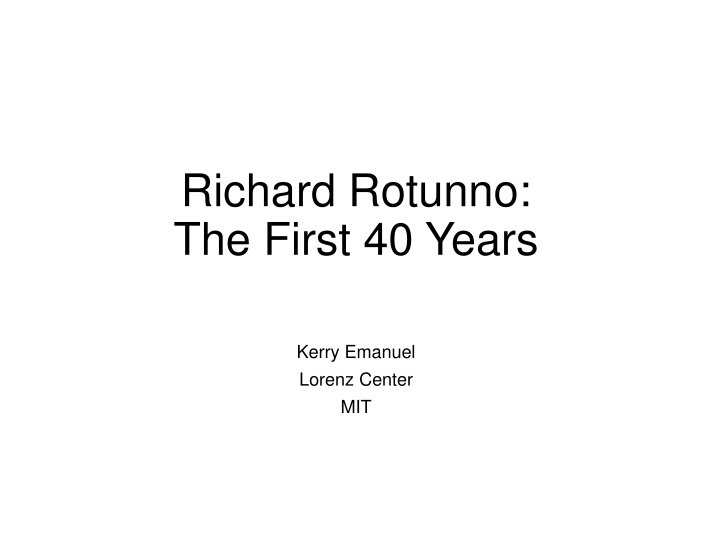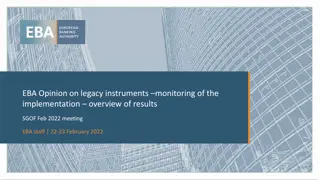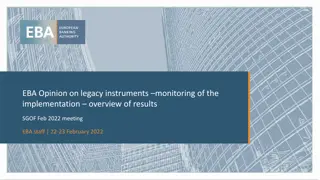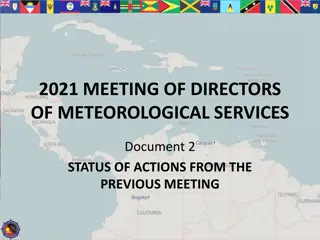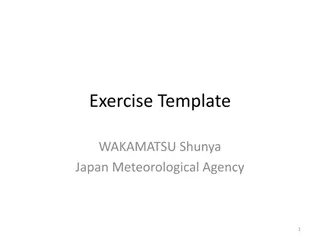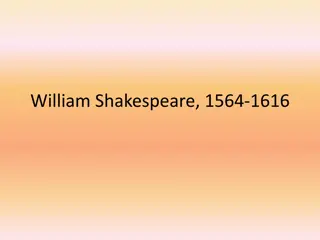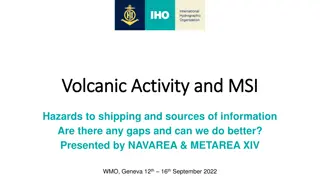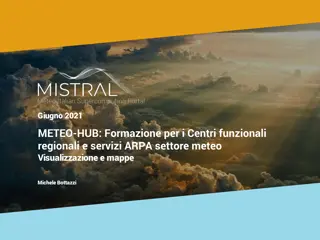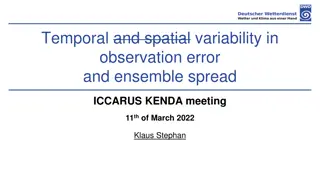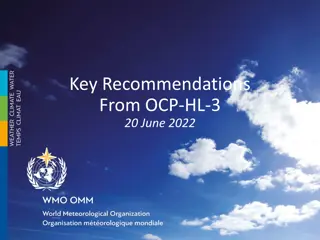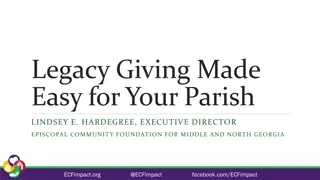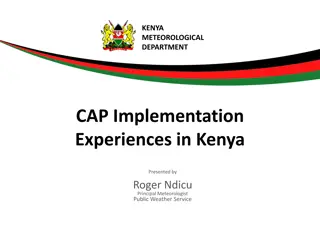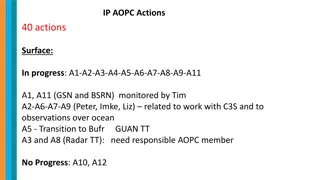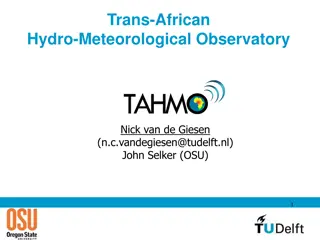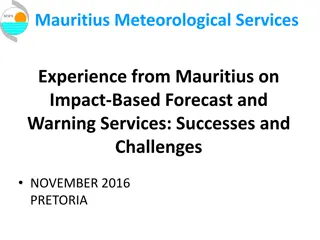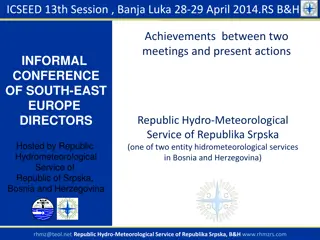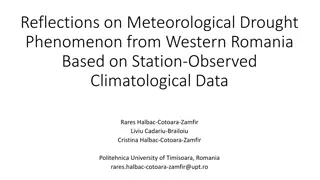Richard Rotunno: A Legacy of Meteorological Excellence
Delve into the remarkable career of Richard Rotunno, spanning four decades of groundbreaking research in atmospheric science. Explore his educational background, career milestones, awards and honors, and major research contributions focusing on vortex dynamics, thunderstorms, tropical cyclones, and more.
Download Presentation

Please find below an Image/Link to download the presentation.
The content on the website is provided AS IS for your information and personal use only. It may not be sold, licensed, or shared on other websites without obtaining consent from the author.If you encounter any issues during the download, it is possible that the publisher has removed the file from their server.
You are allowed to download the files provided on this website for personal or commercial use, subject to the condition that they are used lawfully. All files are the property of their respective owners.
The content on the website is provided AS IS for your information and personal use only. It may not be sold, licensed, or shared on other websites without obtaining consent from the author.
E N D
Presentation Transcript
Richard Rotunno: The First 40 Years Kerry Emanuel Lorenz Center MIT
Program Brief biography Synopsis of research achievements Some personal reflections
Education B.E. (Eng. Science), SUNY Stony Brook, 1971 M.S. (Mechanics), SUNY Stony Brook, 1972 M.A. (Geophysical Fluid Dynamics), Princeton, 1974 Ph.D. (Geophysical Fluid Dynamics), Princeton, 1976 Postdoctoral Fellow, National Center for Atmospheric Research, 1976-1977 Ph.D. Thesis: Internal gravity waves in the nocturnal planetary boundary layer
Some Career Milestones Visiting Fellow, CIRES, University of Colorado, 1977-1978 Research Associate, CIRES, University of Colorado, 1978- 1979 Scientist II, National Center for Atmospheric Research, 1980- 1983 Scientist III, National Center for Atmospheric Research, 1983- 1989 Senior Scientist, National Center For Atmospheric Research, 1989-present Director, Mesoscale and Microscale Meteorology Division, National Center for Atmospheric Research, 2010-2014
Some Awards and Honors 1991: Banner Miller Award 1994: Fellow of the AMS 2004: Jule G. Charney Award 2010: Banner Miller Award 2017: Carl-Gustaf Rossby Research Medal
Major Research Foci Vortex dynamics Dynamics of supercell thunderstorms Squall line dynamics Land-and sea-breezes, nocturnal jets, katabatic and anabatic flows (Dino Zardi) Tropical cyclones, medicanes, and polar lows Alpine flows and vortex shedding by hills (Andrea Buzzi, Vanda Grubi i and Manuela Lehner) Baroclinic instability and frontal dynamics; QG and SG theory Gravity waves, density currents, Kelvin waves and hydraulic jumps (George Bryan) Alpine precipitation and floods (Bob Houze) Fundamental predictability
Major Research Foci Vortex dynamics Dynamics of supercell thunderstorms Squall line dynamics Land-and sea-breezes, nocturnal jets, katabatic and anabatic flows (Dino Zardi) Tropical cyclones, medicanes, and polar lows Alpine flows and vortex shedding by hills (Andrea Buzzi, Vanda Grubi i and Manuela Lehner) Baroclinic instability and frontal dynamics; QG and SG theory Gravity waves, density currents, Kelvin waves and hydraulic jumps (George Bryan) Alpine precipitation and floods (Bob Houze) Fundamental predictability
Vortex Dynamics 1977: Numerical simulation of a laboratory vortex . First attempt to numerically simulate a laboratory vortex (that of Ward, 1972) Confirmed Ward s finding that core size is mostly a function of swirl ratio Showed that core size becomes independent of Reynolds Number when the latter is large Speculated that large swirl ration would lead to multiple vortex formation owing to concentration of vorticity in a cylindrical sheet
Vortex Dynamics 1978: A note on the stability of a cylindrical vortex sheet . Rich showed that the observed azimuthal wavenumbers 1 and 2 could only be explained if there are radial shears in both vertical and azimuthal velocity. 1979: A study in tornado-like vortex dynamics : Extends 1977 work to better resolved boundary layer with no-slip condition. Finds strong swirling flow in corner region and generation of inertial waves 1984: An investigation of a three-dimensional asymmetric vortex . Early 3-D simulation of tornado-like vortices; confirms presence of helical modes and vortex breakdown
Vortex Dynamics 1986: A theory for the maximum wind speeds in tornado-like vortices (with Brian Fiedler): Theoretical development confirms that strongest surface winds occur in supercitical end-wall vortices 1988: A comparative study of atmospheric and laboratory- analogue numerical tornado vortex models (with Howells and Smith): Affirms great importance of secondary circulation produced by no-slip boundary in creating strong boundary layer inflow jet and enabling high velocities near the surface 2016: Axisymmetric tornado simulations at high Reynolds number (with Bryan, Nolan, and Dahl): Confirms that 2-D vortices remain laminar at high Re, suggesting that turbulence requires 3D. Maximum winds can exceed ~3 x thermodynamic limit. 2017: Tornado vortex structure, intensity, and surface wind gusts in large-eddy simulations with fully developed turbulence (with Nolan, Bryan and Dahl): Extends previous work to 3D. Overall vortex intensity reduced by turbulence, but surface gusts can still exceed thermodynamic limit by factor > 2
Dynamics of Supercell Thunderstorms Rich and collaborators have provided a rigorous and highly satisfying picture of the dynamics of supercell thunderstorms, including the appearance of high vorticity at the surface 1981: On the evolution of thunderstorm rotation . Development of precipitation-driven downdraft splits storms and tilting of horizontal vorticity of ambient shear leads to vortex pairs
Dynamics of Supercell Thunderstorms 1982: The influence of the shear-induced pressure gradient on thunderstorm motion (with Klemp). Importance for storm dynamics of dynamically induced pressure gradients, as diagnosed through the nonlinear balance equations 2 2 2 u x v y w z u v y x u z w x v w z y B z = + + + + + 2 2 2 2
Dynamics of Supercell Thunderstorms 1983: A study of the tornadic region within a supercell thunderstorm (with Klemp). Identified baroclinic generation along gust fronts as an important source of low-level vorticity
Squall Line Dynamics 1988: A theory for strong long-lived squall lines and The structure and evolution of numerically simulated squall lines (with Weisman and Klemp). Showed that optimal conditions for quasi-2D squall lines require baroclinic vorticity generation at gust fronts to cancel horizontal vorticity associated ambient low-level shear. Deep shear in certain configurations can promote lines of 3-D supercell storms.
Tropical Cyclones, Medicanes and Polar Lows 1987: An air-sea interaction theory for tropical cyclones. Part II: Evolutionary study using a nonhydrostatic axisymmetric numerical model (with Emanuel). First demonstration that tropical cyclones can amplify in CAPE-free environments given a strong enough starting vortex
Tropical Cyclones, Medicanes and Polar Lows 1988: Polar lows as arctic hurricanes (with Emanuel). Showed that surface flux-driven vortices can develop in observed polar low environments, and that these ae driven mostly by sensible surface heat fluxes. 02:50 GMT 13 December 1982 12 GMT 13 December sounding at Bear Island
Tropical Cyclones, Medicanes and Polar Lows 2008-2009: Five papers on observations and analysis of the 26 September 2006 medicane affecting Puglia, with A. Moscatello, M. Miglietta, S. Davolio, F. Pacifico, and A. Buzzi. One of the papers is in Italian. Showed that this system originated in the lee of the Atlas Mountains and was amplified by surface heat fluxes under a cutoff cold low aloft. Maglie radar reflectivity, 1103 GMT 9/26/2006 WRF simulation 0600 GMT 9/26/2006
Tropical Cyclones, Medicanes and Polar Lows 2008: The influence of near-surface, high-entropy air in hurricane eyes on hurricane intensity (with Bryan): Disproved a hypothesis by Persing and Montgomery that TC superintensity results from surface fluxes in the storm s eye. 2009: An evaluation of an analytic model for the maximum intensity of tropical cyclones (with Bryan): Showed that super intensity is mostly owing to supergradient winds in boundary layer, while gradient wind obeys potential intensity theory. Developed a diagnostic PI that incudes supergradient wind.
Tropical Cyclones, Medicanes and Polar Lows 2009: Large-eddy simulation of an idealized tropical cyclone (with Chen, Wang, Davis, Dudhia, and Holland): Very high (~62 m) resolution 3D simulation of an idealized TC. Shows that transient, 3D wind features can greatly exceed potential intensity and uncovers a wealth of information about the mesoscale structure of TC boundary layers. Instantaneous snapshot of the 10 m wind field produced by the CM1 model ( x = y = 31.25 m).
